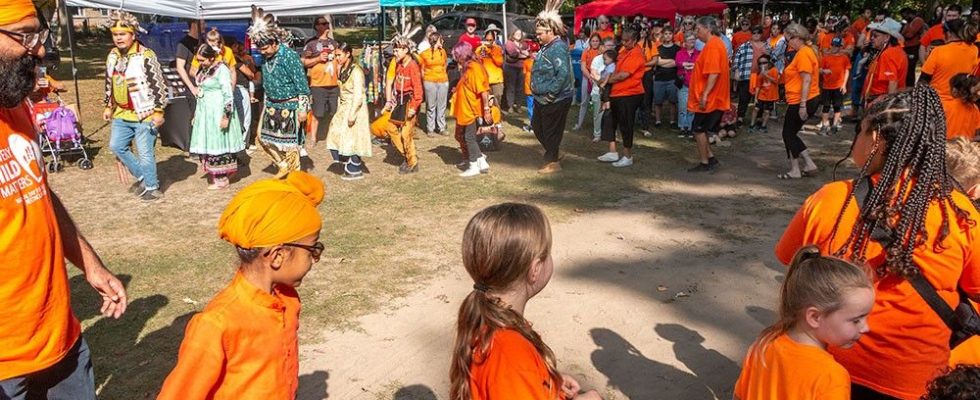
Hundreds of people attended a National Day for Truth and Reconciliation event at Brantford’s Mohawk Park on Saturday.
Advertisement 2
Article content
“We came because we have family and friends that are Indigenous,” said Stephanie Farrow of Brantford. “We feel that this is a very important day to learn as much as we can about it, and we wanted to come and be supportive.”
Article content
CA Culinary Services from Six Nations were prepared to serve tacos to more than 500 people, while visitors could browse dozens of vendor and information booths, learn to throw and catch with lacrosse sticks, and join the Grand River Singers and Dancers in traditional dances.

“We had just learned about this from Niwasa (a multi-service Indigenous organization) in Hamilton, and wanted to come and support,” said Angela Haardeng-Darby of Hamilton who brought her husband and three children to Mohawk Park for the cultural experience. “My grandmother went to a residential school in Cutler, Ontario so it’s near and dear to our hearts.”
Advertisement 3
Article content

At the Woodland Cultural Center on Mohawk Street, a day of programming was geared toward residential school survivors and their families with food and workshops on beading and making Two Row Wampum bracelets.

“We’ve had about 100 people through, which is good with trying to keep things a bit quieter for the survivors,” said WCC executive director Heather George, noting that the adjacent former residential school, the Mohawk Institute was open for survivors to tour on Friday. “I think it’s hard for a lot of people to go through, survivors and their descendants.”
George said that many survivors were interested to see the work that’s been done to save the evidence and see if it’s the way they remembered it when they attended as children.
Advertisement 4
Article content
“The most common concern we hear expressed by survivors is that it’s too nice now,” explained the executive director. “Everything’s been painted and fixed up, there’s new lighting, so that’s the most common complaint is that it’s nicer than when they were there.”
She said she’s grateful that the community decided to save the building – one of only two remaining in Ontario – to help people understand the experiences of children who attended residential schools.
“It is that evidence of the past, and we wouldn’t have been able to tell the same stories with the same impact without having the building.”
Despite the completion of the Save the Evidence campaign to restore the Mohawk Institute, George said that the rise in construction costs over the pandemic has put the project about $1 million short of the final goal.
“(It’s) the funds needed to interpret the space, the signage, (and) listening stations so people can hear the survivor’s stories first hand,” she explained. “We’ve got some re-created furniture pieces that we’re going to have in the building so people can get a sense of what it was actually like to be there as a child.”
Article content

Comments
Postmedia is committed to maintaining a lively but civil forum for discussion and encourages all readers to share their views on our articles. Comments may take up to one hour for moderation before appearing on the site. We ask you to keep your comments relevant and respectful. We have enabled email notifications—you will now receive an email if you receive a reply to your comment, there is an update to a comment thread you follow or if a user you follow comments. Visit our Community Guidelines for more information and details on how to adjust your email settings.